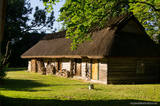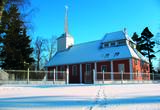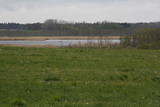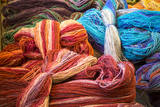| Nr | Name | Beschreibung |
|---|---|---|
|
The craftsman will tell you all about the history of pottery and demonstrate his work. You can commission and purchase his products. Once a year, in July, Mr Klīdzējs fires up the chamber kiln that is at the Salacgrīva School of Art. |
||
|
Die Südspitze der Insel Saaremaa – eine aus Geröll in der Irbenstraße langgestreckte Landzunge. Militärbefestigungen, Leuchtturm (1960), Vogelbeobachtungsort. |
||
|
Der Familienbetrieb befindet sich in der Nähe von Valmiera mit großen Feldern, Ackern und 400 Kühen. Herstellung von Sahne, Quark, Joghurt, Käse, Eiscreme und anderen Produkten aus eigener Kuhmilch. |
||
|
Die drittgrößte Insel Estlands. Ist mit schönem Wachholderhain, kleinen Dolomitaufschlüssen und den Fischerdörfern an der Küste bedeckt. |
||
|
The cafe Staburadze is situated in the centre of the city Kuldiga. |
||
|
Before a great storm in 2005, this was one of the tallest and most noble lime trees in Latvia. Now only one branch is still alive.
|
||
|
Mit heutigen Augen gesehen, scheint es unglaublich, dass noch vor etwa zwanzig Jahren an der Meeresküste speziell gebaute Gebäude mit beeindruckende Scheinwerfer gelegen waren. In der dunkle Zeit des Tages wurden die Scheinwerfer auf besondere Schienen auf die Platformen geschiebt, damit sie das Meeresaquatorium und Strand ausleuchten und die potentiellen Grenzverletzer aufweisen. Aus dem oben erwähneten Objekt sind nur die gebäude und daneben liegenden Gemäuer der Platforme erhalten geblieben, doch auch diese sind von den Meereswellen zerstört worden.
|
||
|
Natālija Rutule owns this workshop in the Alsunga Museum building. She teaches master classes in preparing various health and beauty products. A sound workshop offers a chance to listen to the peaceful sounds of gongs, bells and other instruments. |
||
|
Die Route führt Sie nach Kaunas, durch mehrere litauische Regionalparks und bietet wunderschöne Aussichten auf die Landschaften des Flusses Nemunas. Kaunas ist Litauens zweitgrößte Stadt. Es zeichnet durch seine modernistische Architektur aus. Die Stadt liegt am Zusammenfluss der beiden größten Flüsse Litauens: Nemunas und Neris. Von Lampėdžiai nach Vilkija verläuft der Wald-Wanderweg zwei Tage lang auf kleine Pfade und ländliche Schotterstraßen am rechten Ufer des Flusses Nemunas. Dieser Abschnitt führt Sie durch kleine Dörfer und ist von wunderschönen Flusslandschaften und Ansichten auf Uferwiesen geprägt. Sie nicht die Fähre über den Fluss Nemunas in Vilkija. Die Fähre ist eine der wenigen in den baltischen Staaten, die noch in Betrieb ist. Für die nächsten zwei Tage von Vilkija führt der Wald-Wanderweg durch seine spektakulärsten Etappen im Regionalpark Dubysa: von Kirkšnovė nach Šiluva finden Sie Burghügeln an Flussufern und ab und zu auch historische Kirchen. Dieser Regionalpark erstreckt sich über das Dubysa-Flusstal, das eine Tiefe von 40 m und eine Breite von bis zu 500 m erreicht. Hier kann Sie das hügelige Gelände überraschen. Anschließend führt Sie die Route zur Šiluva – der katholischen Pilgerstätte – und zum Regionalpark Kurtuvėnai. Er gehört zu den dicht bewaldeten Gebieten Mittellitauens, dass der Regionalpark und das Flusstal mit seinen vergletscherten Gebieten ein Wunderland der Wälder, Gewässer und Feuchtgebiete ist. Der Wald-Wanderweg führt kleiner Waldwege, Touristenpfade, wunderschöner Baumalleen und Feuchtgebiete entlang. Die Wanderung endet im Dorf Šaukėnai, von wo aus Šiauliai leicht zu erreichen ist. |
||
|
Das Gutsschloss wurde im 17. – 18. Jh. im Barockstil gebaut. In den 20er Jahren des 19. Jh. wurde es im Stil des Klassizismus umgebaut. In der Zeit zwischem dem Ende des 17. Jh. bis zum 20. Jh. war das größte Landgut Estlands. Hotel, Restaurant, Konferenzzentrm, Museum. |
||
|
Der Tērvete Naturpark befindet sich in einem Gebiet, das nicht besonders typisch für die Zemgale Region ist – im Tērvete - Flusstal. An seinen Ufern gibt es riesige Wälder, die sich gut für Freizeitaktivitäten eignen. Es gibt Naturdenkmäler und auch hervorragende Kultur- und Geschichtsdenkmäler in dieser Gegend. Der Tērvete Landschaftspark ist einer der beliebtesten touristischen Ziele in Zemgale. Die Besucher finden hier einen Wald mit uralten Kiefern, einen herrlichen Landschaftspark, das Sprīdīši-Arboretum, die Burgberge von Tērvete, Klosterkalns and Svētkalns, das Museum “Sprīdīši”, das der großartigen lettischen Autorin Anna Brigadere gewidmet ist, verschiedene Kinderattraktionen, schöne Landschaften, ein enges Netz von Wanderpfaden usw. Dieser Naturpark ist 2004 zum familienfreundlichsten Ort in Lettland ernannt worden.
|
||
|
Roman Catholic Church of Divine Grace – On 19 April 1998, the so-called “White Sunday” or the Day of Divine Grace, Saulkrasti Roman Catholic Church of Divine Grace was consecrated. The building is 24 m long and its tower is 16 m high. The 300-seat church was designed by the architect Jānis Šrēders. The image of Christ on the altarpiece was derived from the vision of the saint, Sister Faustina, of 22 February 1931 in a monastery in Poland. The altarpiece was created by the artist Ēriks Pudzēns. 14 paintings on the walls of the church depict Christ’s path of suffering from conviction to resurrection. The altar is built of ash. On 2 August 1998, a 7.38 m tall cross was consecrated by Saulkrasti Roman Catholic Church of Divine Grace. At night this cross is illuminated. The cross is similar to the cross of Golgotha in Jerusalem where Jesus Christ was crucified. |
||
|
Das Gestüt erwartet als Gäste nicht nur professionelle Reiter oder Leute die Reiten lernen. Für Schüler ab der 6. Klasse werden Führungen angeboten, bei denen diese mit den Tieren bekannt gemacht werden, sie gefüttert werden können und man probieren kann zu reiten. Bei älteren Schülern kann das Programm auch etwas anspruchsvoller sein und Details zur Evolution und Biologie der Pferde enthalten und zur Arbeit mit den Tieren. Zudem werden Reittouren durch die Umgebung auf einfachen Strecken angeboten. |
||
|
Der nördliche Teil der Festung von Liepāja schließt den Kriegshafen ein, den nach der Unabhängigkeit Lettlands zu einem offenen Territorium wurde. Nördliche Forte, Küstenschutzbatterien, die Orthodoxe Meereskathedrale St.Nikolai, Wasserturm, Manege, Gefängnis von Karosta, Nordmole und Oskara Kalpaka-Schiebebrücke. |
||
|
Nature restricted area surrounds Tasu Lake and swampy shores of it in a narrow band. The territory was established to protect rare nesting and migratory birds. The territory is easily overseen from the narrow gravel roads all around the area not entering the actual protected area. Tasu Manor house is located to the South of nature restricted area.
|
||
|
Iespēja atpūsties un relaksēties pirtiņā, baudot latviskos pirts rituālus. Sildīšanās un pēršanās ar pirtsslotām, augu skrubji un maskas, kāju vanniņas un zāļu tējas. Pēc pēriena – veldze dīķī. Pirts tā ir svētnīca miesai, garam un dvēselei. Piedāvājumā arī izglītojošā programma par augu spēku un to izmantošanu savai labsajūtai. Apmeklējums noteikti iepriekš jāpiesaka! Vietu skaits ierobežots! |
||
|
Die Tour beginnt an dem Hafen der ehemaligen Hansestadt Gdansk mit ihrer schönen Altstadt. Danach führt die Tour nach Malbork mit ihrer eindrucksvollen mittelalterlichen Burg und ihren Befestigungen und zu der ruhigen Frombork mit ihrer prachtvollen gotischen Kathedrale. Auf der Tour überquert man die Region der Mazurischen Seen, wo Tausende von Seen mit Flüssen und Kanälen verbunden sind. Am besten kann man die Seen aus einem Boot erleben. Weiter führt die Tour zum Nationalpark Wigry mit seinen Spazierpfaden und interessanten archäologischen Stätten. |
||
|
This is the only factory in Latvia that offers the full processing of wool, and it has been open since the late 19th century. There is a workshop in Dundaga where woollen blankets and pillows are sewn. |
||
|
Der Pfad beginnt bei Kirche von Krimulda. Er führt am Ufer der Runtiņupīte (Runtiņš) bis zur Mündung in die Gauja. Zu besichtigen sind dort das Pfarrhaus, der Burgberg Kubesele, das Denkaml für das Oberhaupt der Liven - Kaupo, die Kubeseler Höhle, der Felsen Saulstaru, der Große Stein, alte Ankerblöcke, Gräberfelder, ein eigenartiges Labyrinth und anderes.
|
||
|
Der Park des Gutes Ilzenbergas, so wie er heute besteht, geht auf eine Anlage der zweiten Hälfte des 19. Jahrhunderts zurück. Die Struktur wird durch das deutliche Relief zwischen den Seen Ilgis und Apvalasas geprägt. Bei der Rekonstruktion wurde Wert darauf gelegt, die räumliche Gliederung unverändert zu belassen. Der Park umfasst ein Territorium von 10 ha und besteht aus zwei Teilen. Zum einen das annähernd rechteckige Gelände am Herrenhaus, eingerahmt von einer Reihe Winterlinden und mit Grünanlagen aus einheimischen und fremdländischen Gehölzen. Zum anderen aus naturnahem, waldartigen Grünanlagen. Die größte in diesem Park wachsende Eiche wurde als staatlich geschütztes Naturerbe eingetragen. Dieser mächtige Baum hat einen Stammumfang von 6,3 m, einen Durchmesser von 2 m und eine Höhe von 30,5 m. |
||


























